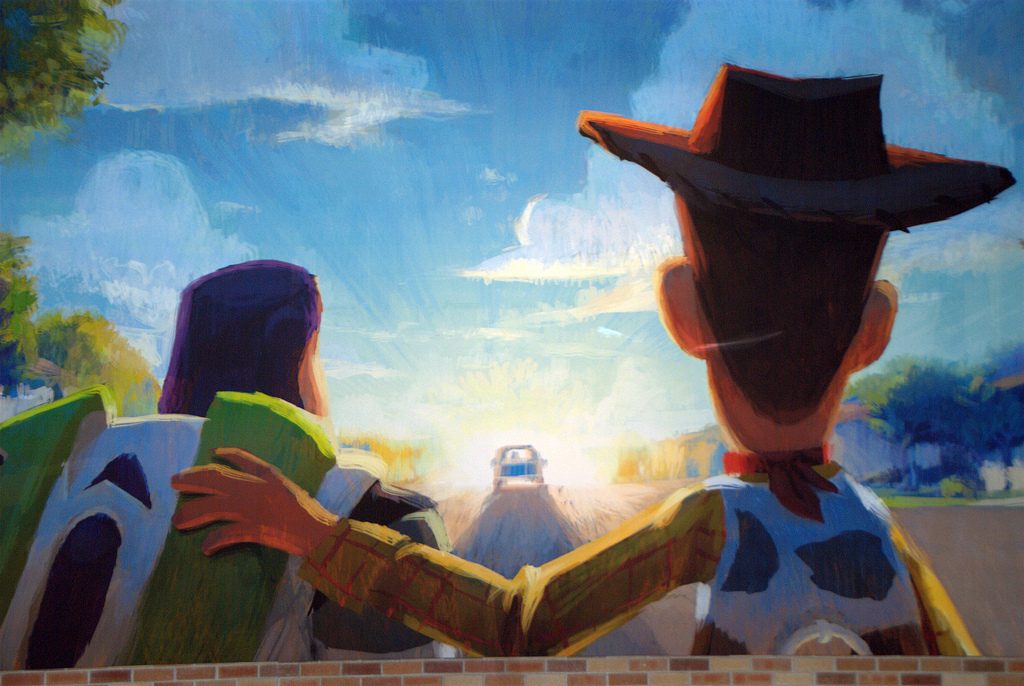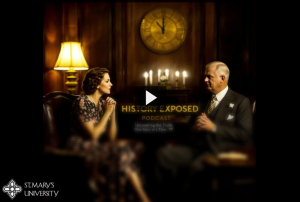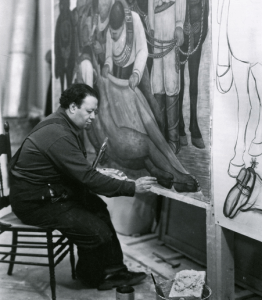Winner of the Fall 2018 StMU History Media Award for
Article with the Best Title
Best Article in the Category of “Cultural History”
“It felt like it had taken a lifetime to get to this point, and in a sense it had.”1
Most of us grew up in a world where toys came to life when Andy wasn’t looking, a world where the monsters in our closet were afraid of us, a world where houses could fly with balloons. Pixar movies have created a world of magic and infinite possibilities. They have brought life and authenticity out of technology. Pixar has created a cinematographic empire like no other. Their success was forged out of mistakes and struggles as well as passion, creativity, and determination. Pixar had to make mistakes in order to grow and create the stories we love today, and they did.
Pixar’s story really starts with three men: Edwin “Ed” Catmull, Steve Jobs, and John Lasseter.

Ed Catmull was turned down for a teaching position and felt he had landed a software development job with no future. Steve Jobs had been humiliated throughout Silicon Valley when Apple Computer, the company he founded, fired him.2 John Lasseter was fired from his dream job as a Disney animator for trying to introduce three-dimensional animation technology there. He was told that if it didn’t make movie production cheaper or faster, it wasn’t worth it.3 All of these men were at a low point in their lives when they became part of the group of people that eventually became Pixar. What brought them out of this uncertain part of their lives was a single goal: to change the way stories are told by pushing the boundaries of what computers can do in animation and graphics by creating the first computer-animated movie in history. These people became the foundation of Pixar Animation Studios.
Not commonly remembered is the company’s inception as the Computer Graphics Division for Lucasfilm, the movie studio behind the Star Wars franchise, beginning in 1979. Through a series of events, Steve Jobs ended up buying this small struggling division in 1986 for five million dollars. He also gave it its iconic name. At that point, the company was selling computer hardware with the Pixar Image Computer as their main product. Their increasingly dwindling revenue also consisted of producing commercials for companies such as Trident and Listerine.4 With their financial struggles, and no clear path into the future of movie-making, Pixar was created.
Pixar’s goal moved further out of reach as they fired one-third of the company in 1991. At that point, Pixar had only sold three hundred Pixar Image Computers. They then decided to stop selling hardware. The five million dollars it had cost Jobs to buy the company had turned into a $54 million money pit. Its only source of revenue, and future survival, was a contract with Disney to produce three movies. There wasn’t even a guarantee that they could make the movies. Nevertheless, the team decided to take a leap of faith into the unknown path of creating computer-animated movies.5
Money was tight and there was constant miscommunication between the Pixar team and Jobs. Jobs was in the middle of establishing NeXT, a computer company he started after Apple. This meant that he rarely appeared in the Pixar offices. The Pixar team felt Jobs did not understand what they needed, and Jobs felt that the Pixar team had no idea how to run a business. Lasseter and Catmull would put out an idea and Jobs would shut it down immediately: the only way was his way. Jobs was described as brilliant and inspirational as well as dismissive, condescending, and bullying. It was clear, Pixar could not survive under Jobs. He simply did not connect with the company leadership and staff, but the company could not survive without him either.6

From the year 1987 to 1991, Jobs attempted to sell Pixar three times. Catmull reflected on this time, saying, “Even if Pixar doubled in value, Steve told me, we still wouldn’t be worth anything.”7 Microsoft, Alias, and Silicon Graphics all tried to acquire the company, but Jobs never sold it. Despite taking millions of dollars of his own money just to keep it afloat, he could not sell. It was his way of saying that he had something other people wanted, something special, that Pixar was worth having, despite its flaws. Every time a company made an offer for Pixar, he acted insulted, suggesting that he believed Pixar was worth much more. It was only after critics predicted that an animated film would be a hit and that Disney signed with Pixar to make their movie, that Jobs gave Pixar one last chance.8
There emerged some hope, as they assembled an excellent but inexperienced team in 1992. Catmull and Jobs began to understand each other and collaborate, and the first computer-animated movie was in its beginning stages. Production of the movie began in early 1993. Their dream was so close that they could see it; their dream was becoming a reality. Their first movie blossomed from Lasseter’s simple idea, the story about a group of toys and a boy.9
Toy Story was going to create a revolution within the technology, art, animation, and entertainment fields. Because this was going to be their debut film under their “mentor” company Disney, Pixar story writers took every advice they gave them to heart. Disney animators were the experts, and they had the success Pixar craved. Disney perceived Woody, a toy cowboy and one of the movie’s main characters, as “too perky, too earnest.”10 An edgier Woody would create a better conflict and a better story. Or so they said.
November 19, 1993 came. It was also known as “Black Friday.” On this day, a mock-up of Toy Story was presented to Disney executives. Months of hard work had been dedicated to making this idea become a reality, and finally … Disney shut down the project. There would not be an animated movie until they fixed the script.
They had technology and talent, but the entire concept was just not right. Something crucial was missing. For the next couple of months Lasseter, Catmull, and the entire team worked every possible moment to rediscover the soul of the project. By this time, special effects were starting to enter mainstream cinematography, with movies such as Jurassic Park and Terminator 2. People enjoyed the manner in which technology enhanced the movie experience, and Pixar was ready to be part of this innovation wave.

The answer to their story problem was simple. They hit on the idea of a story of a boy and his toy cowboy. This experience taught them to trust their own abilities, to give Pixar its own character, and to do things the Pixar way.11
November 22, 1995. Toy Story was released to the world, to infinity and beyond.12
In total, Toy Story earned $362 million worldwide, it was a phenomenon. It had created an ingenious and creative new storytelling method. Now the graphics on the movie screen were perceived as having emotion and character. The movie had characters that had life in a way that was unprecedented from anything animators had done before. Pixar was able to create this emotional response because the overall theme was so human and relatable. With themes such as friendship, change, finding who you truly are, and your purpose in life, it is no surprise that though this movie was made for a young audience, it resonated with people of all ages. It was a masterpiece.13
The following year, Toy Story was nominated for three Academy Awards. John Lasseter received a Special Achievement Award. And Pixar announced its retirement from making commercials in order to focus on making more movies.
Due to its success with Toy Story, Disney pursued a partnership with Pixar. Shortly afterward, Pixar decided to open their company stock to the public. With this, they earned $140 million for the company. Pixar had accomplished something it had never done before; it was now a stable company.14
What started off as a constantly struggling company became an animation empire. Their stories have since touched the lives and hearts of people around the world. They’ve made us cry and they’ve made us laugh. Ed Catmull, Steve Jobs, and John Lasseter came together to change the world by creating the first computer-animated movie.
The rest is history.
- Edwin Catmull and Amy Wallace, Creativity, Inc.: overcoming the unseen forces that stand in the way of true inspiration (New York: Random House, 2014), 56. ↵
- David A. Price, The Pixar Touch: The Making of a Company (New York: Vintage Books, 2009), 8. ↵
- Bill Capodagli and Lynn Jackson, Innovate The Pixar Way: Business Lessons from the World’s Most Creative Corporate Playground (New York: McGraw-Hill, 2009), 31. ↵
- “Our Story,” Pixar, accessed August 31, 2018, https://www.pixar.com/our-story-1#our-story-main. ↵
- Edwin Catmull and Amy Wallace, Creativity, Inc.: overcoming the unseen forces that stand in the way of true inspiration (New York: Random House, 2014), 53. ↵
- Edwin Catmull and Amy Wallace, Creativity, Inc.: overcoming the unseen forces that stand in the way of true inspiration (New York: Random House, 2014), 51-52. ↵
- Edwin Catmull and Amy Wallace, Creativity, Inc.: overcoming the unseen forces that stand in the way of true inspiration (New York: Random House, 2014), 54. ↵
- Edwin Catmull and Amy Wallace, Creativity, Inc.: overcoming the unseen forces that stand in the way of true inspiration (New York: Random House, 2014), 53; “Our Story,” Pixar, accessed August 31, 2018, https://www.pixar.com/our-story-1#our-story-main. ↵
- Edwin Catmull and Amy Wallace, Creativity, Inc.: overcoming the unseen forces that stand in the way of true inspiration (New York: Random House, 2014), 54. ↵
- Edwin Catmull and Amy Wallace, Creativity, Inc.: overcoming the unseen forces that stand in the way of true inspiration (New York: Random House, 2014), 57. ↵
- Edwin Catmull and Amy Wallace, Creativity, Inc.: overcoming the unseen forces that stand in the way of true inspiration (New York: Random House, 2014), 57. ↵
- “Our Story,” Pixar, accessed August 31, 2018, https://www.pixar.com/our-story-1#our-story-main. ↵
- David A. Price, The Pixar Touch: The Making of a Company (New York: Vintage Books, 2009), 151. ↵
- Edwin Catmull and Amy Wallace, Creativity, Inc.: overcoming the unseen forces that stand in the way of true inspiration (New York: Random House, 2014), 60. ↵



201 comments
Jose Chaman
I always had Steve Jobs as the main image of Pixar, however, thanks to this great article, I could discover that Pixar was formed thanks to the necessary collaboration of two other people: Ed and John. I didn’t know that Pixar had started selling computers, much less that its beginnings had been so turbulent and unpredictable, however, always a stroke of luck and genius can mean a outright success, as it was with Pixar.
Cristianna Tovar
The fact that the individuals who made Pixar come to life were previously rejected in their field of work is inspiring. Although they weren’t “good enough” for the people who fired them, Steve Jobs, Edwin Catmull, and John Lasseter knew their worth and decided to continue to pursue their dreams. Pixar made many of our childhoods memorable and exciting. The fact that Pixar may not have existed if these men had listened to those who had fired them is truly heartbreaking. It just goes to show that as long as there’s a will, there’s a way.
Emmanuel Diaz
In all honesty i appreciate this article. I never knew that Steve Jobs was one of the heads of pixar and didn’t know that he was actually in charger of the money behind it. Toy story hits close to home for me as i remember sitting in the living room with my family and watching it on our VCR. I also never knew that Pixar actually started off as a commercial company. Hearing the challenges that pixar faced is shocking. I understand that companies face many challenges when starting up but they continuously had to restart over and over again especially with their one chance to pull themselves out of their financial hole they had dug themselves into.
Marco Monte de Oca
I was surprised when I read that Steve Jobs was a part of the beginning of Pixar. I also didn’t know that Steve Jobs put a lot of his own money into the company to keep it afloat. Since he did that, he saved what has become such a big part of many people’s lives. Pixar’s movies are something I grew up with and to this day, I still rewatch them and get filled up with emotions. It’s remarkable what Pixar has done when it was so close to not even being able to create its first movie.
Todd Brauckmiller Jr.
I could not believe my eyes when I saw that Steve Jobs had helped created Pixar. This article really touched on a lot of old memories that I hold very near and dear to my heart. Such very emotional moments Pixar has created from their movies really puts a smile on my face. Even though Toy Story was a great success I could not even comprehend the struggles and set backs the company must have endured. Great article I think this company has created many beautiful masterpieces and I hope more people discover what it is you have wrote about.
Briana Montes
This was a good read overall I feel like I learned a lot more than I already knew. I grew up watching Toy Story it was one of my favorites as a kid. I found it interesting that Steve Jobs contributed to the creation of Pixar. This was a very good read and very well written I also found it interesting that Disney refused them till they partnered up with Pixar.
Margaret Maguire
Pixar makes really good movies but I never knew about the history of the movies. I had no idea that Steve Jobs, the creator of Apple, tried to create Pixar and I also had no idea that someone could be fired from their own company. I also thought it was really cool that Toy Story was first going to be produced by Disney and they shot the idea down. Toy Story also made millions worldwide, I wonder who made the final call to send the idea of Toy Story away because I would have felt so bad for missing out on something so amazing.
Sofia Martinez
I never knew that Pixar had relations with Steve Jobs, as he was known for being the creator for Apple, and being part of the trio company, that would soon become on the biggest platforms for movies for Disney. It is very important to know that the three men struggled to get to where they got in order to achieve the popularity of their company.
Audrey Uribe
Never knew steve jobs had an affiliation with pixar! Was unaware that pixar started making commercials and not movies. Glad special effects came out around this era due to the fact that all the amazing classics is what made up this new generation and the ideas that followed it. Very informative article of one of the most successful businesses of all time. Pixar with Disney created a lot of kids childhood and will continue to tell kids childhood with joy.
Addie Piatz
The Toy Story movie were instant classics. Bringing a sense of childhood to people of all ages. Pixar was a big part of my childhood. Great movies one after the other all became my new favorite at one point or another. One thing that I found very interesting was Steve Jobs contribution to the creation of Pixar. As if the man didn’t create enough already.